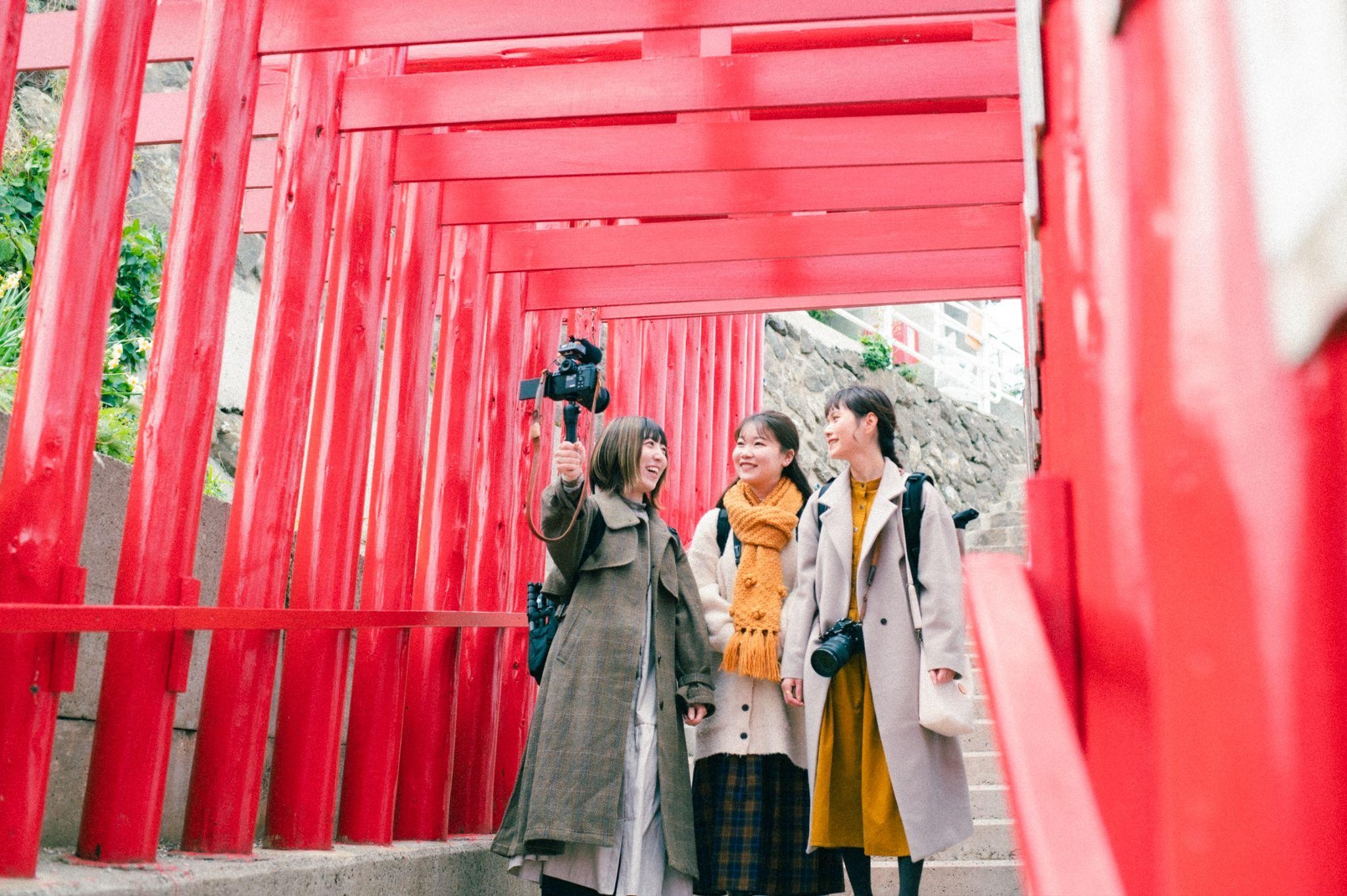- >
- Features
- >
- You definitely want to take pictures! Photo Spot & Photography Techniques of Motonosumi Shrine
You definitely want to take pictures! Photo Spot & Photography Techniques of Motonosumi Shrine
topics-
Last updated
Jul 31, 2025

Motonosumi Shrine, located in Nagato City, Yamaguchi Prefecture, is known as a scenic spot not only in the Japanese media, but also from overseas, as it was selected as one of the "36 Most Beautiful Places in Japan" by CNN.
Did you know that there are photo spots and photography techniques that you should know in order to capture the spectacular view of Motonosumi Shrine with your camera?
In this article, we have compiled information on photo spots at Motonosumi Shrine.
It also covers information on the best photo spots around Motonosumi Shrine, so please take a look at it as a reference for your travel plans.
*Please take photos while observing the hours of worship (9:30-16:30).
*Photographing outside the grounds (around the torii gate) is allowed even outside of worship hours.
What is Motonosumi Shrine?

Photo: Koichi(@Kfish1882)/Cooperation: NICO STOP)
Motonosumi-jinja Shrine is famous for its view of 123 torii gates lined up against a precipitous cliff.
|
name |
Motonosumi Shrine |
|
address (e.g. of house) |
498, Aburatayatsukou, Nagato City, Yamaguchi Prefecture, Japan |
|
Phone number |
0837-26-0708(Tourist Information Center "YUKUTE) |
|
holiday |
open every day of the year |
|
Hours of Prayer |
9:30~16:30 |
|
Admission Fee |
Free (paid) |
|
Other |
parking lot |
The shrine has long been popular with local residents, who believe it is blessed with benefits such as business success, safety on the sea, and good luck and good luck repelling bad luck.
In recent years, it has become known as a beautiful spot with a spectacular collaboration of the Sea of Japan and the red torii gate, and has gained popularity among tourists from Japan and abroad.
Four recommended photo spots at Motonosumi Shrine

Motonosumi Shrine is a profound sightseeing spot where the expression of the scenery changes dramatically depending on where you photograph.
Here are five recommended photo spots that you should know about to get the most out of Motonosumi Shrine.
Depending on the shooting spot, we will also introduce examples with detailed summaries of camera settings, etc., for your reference.
The top of the torii gate

From the top of the torii gate, visitors can successfully look down on the Japan Sea and the torii gates that line the precipitous cliffs, providing a view that can only be seen at Motonosumi Shrine and captured with a camera.
The contrast of the deep blue of the Sea of Japan, the historical red of the torii gate, and the lush green of the vegetation is sure to make for a great photo opportunity.
The top of the torii gate Example
|
season |
Late May |
|
weather |
clear weather |
|
Shooting position |
under the grand torii (gate) |
|
focal length (distance) |
24mm |
|
F value |
8 |
|
shutter speed (camera) |
1/250 sec. |
|
ISO |
160 |
In summer, the contrast is even more beautiful because of the deep greenery all around.
Around the Tidal Blow of the Dragon Palace

Located near Motonosumi Shrine, Ryugu no Ushibuki is a powerful sightseeing spot where the waves of the Sea of Japan make a powerful spray from the unique rock formations. The tidal blast can be seen mainly in winter when the north wind is strong, but when the waves are calm, it provides a spectacular view of the Sea of Japan from the top of the cliff.
Located near Motonosumi Shrine, be sure to visit the "Tatsunomiya no Siofuki" as well.

large torii
Motonosumi Shrine is home to the 6-meter-high Otorii (Grand Gate).
At the top of the 6-meter-tall torii, which is rare in Japan, there is a money-offering box where visitors can enjoy throwing money. Let's take pictures of the powerful scene where your companion throws the money offering!
If you want to include the entire torii, use an aperture of f/8 or more to get a wide focus area and a fast shutter speed of 1/500 second or more to reduce blurring. It is also important to lower the ISO as much as possible to reduce noise.
Otorii gate Example

|
season |
Early Jan. |
|
weather |
Sunny with a few clouds |
|
Shooting position |
large torii |
|
focal length (distance) |
24mm |
|
F value |
2.8 |
|
shutter speed (camera) |
1/2000 sec. |
|
ISO |
400 |
It is also possible to take a smiling photo of the visitors as they throw money into the money-offering box on top of the Otorii gate, reminding them of a fun time on their trip.
The Stone of Difficulty
The "Stone of Difficulty" is a stone tunnel through which one is supposed to "break through difficulties" by passing through.
If you can capture the moment when the visitors try their best to pass through the stone tunnel under the white fox, you will be able to leave behind a pleasant memory unique to Motonosumi Shrine.
If you want to take an interesting picture, you should try diving with your right shoulder down, your right hand extended in front of you, and your whole body turned to the left.
Points to be aware of when taking pictures at Motonosumi Shrine

To take beautiful pictures of the scenery of Motonosumi Shrine, one must pay attention not only to the location and angle of view, but also to the environment in which the pictures are taken.
Here are some points to be aware of when taking pictures at Motonosumi Shrine, in terms of time of day and seasonal characteristics.
time zone
The best time to photograph the entire shrine with forward light toward the ocean side is from 10:00 to 12:00 during the summer season.
In addition, the following characteristics of the way the sun shines are also observed in each season.
- Spring to summer: The sun moves slightly north from east to west toward the sea that stretches to the north, so it is difficult to get shade during the daytime.
- Autumn - Winter: The sun moves slightly south from east to west, often casting shadows on the torii gate, especially in the morning.
Please observe the hours of worship (9:30 am to 4:30 pm from August 1, 2025).
Seasonal Features
The scenery of Motonosumi Shrine changes dramatically with the color of the sea in different seasons and the growth of plants on the shrine grounds.
- Spring to summer: Blue skies are easy to see, and it is easy to clearly capture the red of the torii gate, the green of the plants, and the blue of the ocean.
- Autumn - Winter: The ocean is deeper and heavier in color, and vegetation is less green, making it easier to capture a stately image. The north wind tends to blow easily, so it is possible to photograph not only rough waves, but also "Ryugu no Siofuki" together on days when the waves are high!
What are the recommended photo spots around Motonosumi Shrine?

Yamaguchi Prefecture is home to abundant nature and a wide variety of landforms, and there are many other scenic spots in addition to Motonosumi Shrine.
Here are five recommended photo spots that are easily accessible from Motonosumi Shrine.
Why not take a look at them when planning your trip to Yamaguchi Prefecture?
rocky outcrop
Senjidashiki is a sightseeing spot where you can view the Sea of Japan and the islands of Yamaguchi Prefecture from a grassy plain at an elevation of 333 meters above sea level.
|
name |
SENJOJI JIKI |
|
address (e.g. of house) |
1138-1 Hiokinaka, Nagato City, Yamaguchi Prefecture |
|
Phone number |
0837-26-0708(Namon City Tourism & Convention Association) |
|
Access from Motonosumi Shrine |
10 minutes by car |
Located within a short distance from Motonosumi Shrine, this is a must-stop photo spot for those who want to capture the beauty of nature.
Terraced rice field flower terrace
Tanada no Hana-dan is a sightseeing spot that is gradually gaining attention for its beautiful herb fields and flower beds that make use of terraced rice paddies that have been abandoned.
|
name |
Tanada no Hanadan (flower terrace in a terraced rice field) |
|
address (e.g. of house) |
1766 Aburaya-Gobata, Nagato City, Yamaguchi Prefecture |
|
Phone number |
0837-27-0074(Namon City Tourism & Convention Association) |
|
Access from Motonosumi Shrine |
5 minutes by car |
In addition to capturing the beautiful scenery, events are often held where visitors can enjoy menus featuring Hanadan's herbs and crops.
For more information, check out the official Instagram.
sandbar that projects into the ocean, particularly in a wavy form
Ohama is a sandy beach located in the Aburatani and Mukozugu areas, where the contrast between the clear, clean sea and the white sandy beach is wonderful.
|
name |
Ohama |
|
address (e.g. of house) |
1068-1, Aburaya Mukouzugami, Nagato City, Yamaguchi Prefecture |
|
Phone number |
0837-23-1252(Namon City Hall Tourism Policy Division) |
|
Access from Motonosumi Shrine |
20 minutes by car |
The clear blue of the beautiful ocean has a charm that will keep you coming back again and again, as the hues vary with the seasons.
cape (on coast)
Cape Kawajiri is located at the northernmost tip of the Mukatugu Peninsula and offers a spectacular view.
|
name |
Cape Kawajiri |
|
address (e.g. of house) |
Yamaguchi Prefecture, Nagato City, Aburatani Mukouzugushita |
|
Phone number |
0837-26-0708 |
|
Access from Motonosumi Shrine |
30 minutes by car |
The vast Sea of Japan, which can be viewed because it is the northernmost point of the island, is an impressive sight unlike anything you would normally see.
Kakushima Bridge
Kakunoshima Ohashi Bridge connects the mainland and Kakunoshima Island, a bridge so well located that it has been the site of many TV commercials and filming locations.
|
name |
Kakunoshima Ohashi Bridge |
|
address (e.g. of house) |
Kanda~Kakushima, Toyokita-cho, Shimonoseki City, Yamaguchi Prefecture |
|
Phone number |
083-786-0234 |
|
Access from Motonosumi Shrine |
30 minutes by car |
Boasting a length of 1,780 meters, it is one of the largest bridges in Japan that can be crossed free of charge, making it a must-see tourist attraction when visiting Yamaguchi Prefecture.
summary

Photo: Koichi(@Kfish1882)/Cooperation: NICO STOP)
In this article, information about photo spots at Motonosumi Shrine is explained.
Motonosumi Shrine, with its beautiful collaboration of the Sea of Japan and the red torii gate, is a recommended sightseeing spot for those who want to take beautiful pictures.
There are also many sights around Motonosumi Shrine that are full of unique scenery, so camera hobbyists are encouraged to visit.
Photo: Koichi (@Kfish1882 )/Cooperation: NICO STOP )


